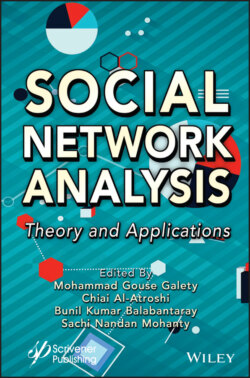Social Network Analysis

Реклама. ООО «ЛитРес», ИНН: 7719571260.
Оглавление
Группа авторов. Social Network Analysis
Table of Contents
List of Tables
List of Illustrations
Guide
Pages
Social Network Analysis. Theory and Applications
Preface
1. Overview of Social Network Analysis and Different Graph File Formats
1.1 Introduction—Social Network Analysis
1.2 Important Tools for the Collection and Analysis of Online Network Data
1.3 More on the Python Libraries and Associated Packages
1.4 Execution of SNA in Terms of Real-Time Application: Implementation in Python
1.5 Clarity Toward the Indices Employed in the Social Network Analysis
1.5.1 Centrality
1.5.2 Transitivity and Reciprocity
1.5.3 Balance and Status
1.6 Conclusion
References
2. Introduction To Python for Social Network Analysis
2.1 Introduction
2.2 SNA and Graph Representation
2.2.1 The Common Representation of Graphs
2.2.2 Important Terms to Remember in Graph Representation
2.3 Tools To Analyze Network
2.3.1 MS Excel
2.3.2 UCINET
2.4 Importance of Analysis
2.5 Scope of Python in SNA
2.5.1 Comparison of Python With Traditional Tools
2.6 Installation
2.6.1 Good Practices
2.7 Use Case
2.7.1 Facebook Case Study
2.8 Real-Time Product From SNA
2.8.1 Nevaal Maps
References
3. Handling Real-World Network Data Sets
3.1 Introduction
3.2 Aspects of the Network
3.3 Graph
3.3.1 Node, Edges, and Neighbors
3.3.2 Small-World Phenomenon
3.4 Scale-Free Network
3.5 Network Data Sets
3.6 Conclusion
References
4. Cascading Behavior in Networks
4.1 Introduction
4.1.1 Types of Data Generated in OSNs
4.1.2 Unstructured Data
4.1.3 Tools for Structuring the Data
4.2 User Behavior
4.2.1 Profiling
4.2.2 Pattern of User Behavior
4.2.3 Geo-Tagging
4.3 Cascaded Behavior
4.3.1 Cross Network Behavior
4.3.2 Pattern Analysis
4.3.3 Models for Cascading Pattern
References
5. Social Network Structure and Data Analysis in Healthcare
5.1 Introduction
5.2 Prognostic Analytics—Healthcare
5.3 Role of Social Media for Healthcare Applications
5.4 Social Media in Advanced Healthcare Support
5.5 Social Media Analytics
5.5.1 Phases Involved in Social Media Analytics
5.5.2 Metrics of Social Media Analytics
5.5.3 Evolution of NIHR
5.6 Conventional Strategies in Data Mining Techniques
5.6.1 Graph Theoretic
5.6.2 Opinion Evaluation in Social Network
5.6.3 Sentimental Analysis
5.7 Research Gaps in the Current Scenario
5.8 Conclusion and Challenges
References
6. Pragmatic Analysis of Social Web Components on Semantic Web Mining
6.1 Introduction
6.2 Background. 6.2.1 Web
6.2.2 Agriculture Information Systems
6.2.3 Ontology in Web or Mobile Web
6.3 Proposed Model
6.3.1 Developing Domain Ontology
6.3.2 Building the Agriculture Ontology with OWL-DL
6.3.2.1 Building Class Axioms
6.3.3 Building Object Property Between the Classes in OWL-DL
6.3.3.1 Building Object Property Restriction in OWL-DL
6.3.4 Developing Social Ontology
6.3.4.1 Building Class Axioms
6.3.4.2 Analysis of Social Web Components on Domain Ontology Under Agriculture System
6.4 Building Social Ontology Under the Agriculture Domain. 6.4.1 Building Disjoint Class
6.4.2 Building Object Property
6.5 Validation
6.6 Discussion
6.7 Conclusion and Future Work
References
7. Classification of Normal and Anomalous Activities in a Network by Cascading C4.5 Decision Tree and K-Means Clustering Algorithms
7.1 Introduction
7.1.1 Cascade Blogosphere Information
7.1.2 Viral Marketing Cascades
7.1.3 Cascade Network Building
7.1.4 Cascading Behavior Empirical Research
7.1.5 Cascades and Impact Nodes Detection
7.1.6 Topologies of Cascade Networks
7.1.7 Proposed Scheme Contributions
7.2 Literature Survey
7.2.1 Network Failures
7.3 Methodology. 7.3.1 K-Means Clustering for Anomaly Detection
7.3.2 C4.5 Decision Trees Anomaly Detection
7.4 Implementation
7.4.1 Training Phase Zi
7.4.2 Testing Phase
7.5 Results and Discussion
7.5.1 Data Sets
7.5.2 Experiment Evaluation
7.6 Conclusion
References
8. Machine Learning Approach To Forecast the Word in Social Media
8.1 Introduction
8.2 Related Works
8.3 Methodology
8.3.1 TF-IDF Technique
8.3.2 Times Series
8.4 Results and Discussion
8.5 Conclusion
References
9. Sentiment Analysis-Based Extraction of Real-Time Social Media Information From Twitter Using Natural Language Processing
9.1 Introduction
9.1.1 Applications for Social Media
9.1.2 Social Media Data Challenges
9.2 Literature Survey
9.2.1 Techniques in Sentiment Analysis
9.3 Implementation and Results
9.3.1 Online Commerce
9.3.2 Feature Extraction
9.3.3 Hashtags
9.3.4 Punctuations
9.4 Conclusion
9.5 Future Scope
References
10. Cascading Behavior: Concept and Models
10.1 Introduction
10.2 Cascade Networks
10.3 Importance of Cascades
10.4 Purposes for Studying Cascades
10.5 Collective Action
10.6 Cascade Capacity
10.7 Models of Network Cascades
10.7.1 Decision-Based Diffusion Models
10.7.2 Probabilistic Model of Cascade
10.7.3 Linear Threshold Model
10.7.4 Independent Cascade Model
10.7.5 SIR Epidemic Model
10.8 Centrality
10.9 Cascading Failures
10.10 Cascading Behavior Example Using Python
10.11 Conclusion
References
11. Exploring Social Networking Data Sets
11.1 Introduction
11.1.1 Network Theory
11.1.2 Social Network Analysis
11.2 Establishing a Social Network
11.2.1 Designing the Symmetric Social Network
11.2.2 Creating an Asymmetric Social Network
11.2.3 Implementing and Visualizing Weighted Social Networks
11.2.4 Developing the Multigraph for Social Networks
11.3 Connectivity of Users in Social Networks
11.3.1 The Degree to which a Network Exists
11.3.2 Coefficient of Clustering
11.3.3 The Shortest Routes and Length Between Two Nodes
11.3.4 Eccentricity Distribution of a Node in a Social Network
11.3.5 Scale-Independent Social Networks
11.3.6 Transitivity
11.4 Centrality Measures in Social Networks
11.4.1 Centrality by Degree
11.4.2 Centrality by Eigenvectors
11.4.3 Centrality by Betweenness
11.4.4 Closeness to All Other Nodes
11.5 Case Study of Facebook
11.6 Conclusion
References
Index
WILEY END USER LICENSE AGREEMENT
Отрывок из книги
Scrivener Publishing
.....
16. Sîrbu, A., Loreto, V., Servedio, V.D., Tria, F., Opinion dynamics: models, extensions and external effects, in: Participatory Sensing, Opinions and Collective Awareness, pp. 363–401, 2017.
17. Sîrbu, A., Loreto, V., Servedio, V.D., Tria, F., Opinion dynamics with disagreement and modulated information. J. Stat. Phys., 151, 1, 218–237, 2013.
.....